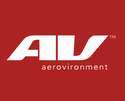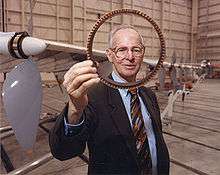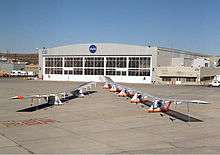AeroVironment
 | |
| Public | |
| Traded as | NASDAQ: AVAV |
| Industry | Aerospace, Energy |
| Founded | 1971 |
| Headquarters | Monrovia, California, United States |
Key people | Paul B. MacCready, Jr., Founder |
| Revenue |
|
|
| |
|
| |
| Total assets |
|
| Total equity |
|
| Website | www.avinc.com |



AeroVironment, Inc. is an American technology company in Monrovia, California, and Simi Valley, California, that is primarily involved in energy systems, electric vehicle systems, and unmanned aerial vehicles (UAVs). Paul B. MacCready, Jr., a designer of human-powered aircraft, founded the company in 1971. The company is probably most well known for developing a series of lightweight human-powered and then solar-powered vehicles. AeroVironment is the Pentagon's top supplier of small drones — including the Raven, Wasp and Puma models. They have signed a strategic partnership with Lockheed Martin Corp to develop their 'Global Observer' to provide "persistent airborne observation".[2]
Vehicles developed
Among the vehicles the company built are:
- Gossamer Condor - The first successful human-powered airplane. The Gossamer Condor is on display at the National Air and Space Museum, since it won the first Kremer Prize in 1977.
- Gossamer Albatross - In 1979 this human-powered plane flew 23 miles (37 km) across the English Channel and claimed the largest prize in aviation history. Another of these planes is displayed at the National Air and Space Museum.
- Gossamer Penguin - A solar-powered variant of the Gossamer Albatross.
- Solar Challenger - This plane flew 163 miles (262 km) from Paris France to England on solar power.
- High Altitude Solar (HALSOL)-This solar-powered unmanned aircraft was sponsored by the CIA in the 1980s as the first unmanned solar-powered aircraft in history prototyped for national security missions. It was declassified and transferred to the Ballistic Missile Defense Organization (BMDO) in 1993 where it was modified as a high altitude, long endurance (HALE) UAV technology demonstrator capable of becoming weaponized to destroy theater ballistic missiles in the boost phase of flight (called Boost Phase Intercept). Lawrence Livermore National Laboratory was the executing agent for the BMDO program. Dr. Nick Colella and Dr. Lowell Wood led the LLNL efforts for the BMDO program manager, LtCol (USAF) Dale Tietz. Ray Morgan led the program in AeroVironment alongside Dr. Paul MacCready and Tim Conver. This was a fast-paced demo program supported at the highest levels of government. The ultimate goal was to develop the world's first "fly forever" HALE UAV that could be configured for a variety of national security missions. The program was cancelled in 1995 due to budget reductions in the Clinton Administration at which time the aircraft, called Pathfinder, was transferred to NASA for a new program. Pathfinder flew several flight test missions at NASAs Dryden Flight Research Center before the property transfer occurred. BMDO and LLNL also started initial development of new, ultra-lightweight hypersonic interceptor rockets that could be deployed from Pathfinder and its derivatives. The interceptor, called Astrid, flew several successful missions during this time period at Vandenberg AFB, CA.
- NASA Pathfinder and Pathfinder Plus - This unmanned plane, built by AeroVironment as a part of the NASA ERAST Program, demonstrated that an airplane could stay aloft for an extended period of time fueled purely by solar power. After initial successes, the Pathfinder was rebuilt into the larger Pathfinder Plus, which is also on display at the National Air and Space Museum.[3] Dale Tietz from the Pentagon's BMDO program transferred the Pathfinder aircraft to NASA for the ERAST Program, where AeroVironment managed its development as a non-weaponized variant.
- NASA Centurion - The Centurion was an expansion of the Pathfinder concept, designed to achieve the ERAST Program goal of sustained flight at 100,000 feet (30,000 m) altitude.[3]
- NASA Helios Prototype - Derived from the Centurion, this solar cell and fuel cell powered UAV set a world record for flight at 96,863 feet (29,524 m). It was intended to be the prototype for the production Helios aircraft, envisioned as an "atmospheric satellite". The ERAST program was terminated in 2003, and as of 2008 Helios has not entered production.[3] In actuality, it has been reborn in the form of the Global Observer UAS, currently in development under a Joint Concept Technology Demonstration led by USSOCOM.[4] The key technology shift was switching from solar power to liquid hydrogen power.
- AeroVironment Global Observer - The Los Angeles Times reported first flight of Global Observer happening at the Mojave Desert in the first week of January, 2011.[5] Global Observer is powered from hydrogen, appears to have 4 motors with twin-bladed props, has a 175-foot (53 m) wingspan, 65,000-foot (20,000 m) maximum altitude, airspeed greater than 120 mph (190 km/h), and 5 to 7 day maximum flight duration.[6]
- Sunraycer - This solar-powered car won the first world's first solar car race in Australia in 1987. The next fastest car finished two days after the Sunraycer. This car is at the Smithsonian National Museum of American History.
- GM Impact - This was an electric car, developed as a serious prototype for a mass-production consumer car.
- AeroVironment RQ-11 Raven - a small military UAV. It is hand launched with a wingspan of 4.5 feet (1.4 m) and a weight of 4.2 pounds (1.9 kg), providing color and infrared video to its handheld ground control as well as remote viewing stations. Over 9,000 Ravens have been delivered or are on order as of June 2008.
- AeroVironment Wasp III - a miniature, hand-launched production UAV that provides aerial observation at line-of-sight ranges up to 3.1 miles (5.0 km). In 2007, the Wasp was selected by the US Air Force as the choice for their BATMAV Program.[7] As of 2008, over 1,000 Wasp aircraft have been delivered to customers worldwide.
- AeroVironment RQ-20 Puma - a small lightweight, battery powered, hand-launched production UAV that provides aerial observation at line-of-sight ranges up to 6.2 miles (10.0 km). Puma's avionics enable autonomous flight and precise GPS navigation. It was originally designed to demonstrate advanced propulsion technologies for such aircraft. It flew in June 2007 for five hours[8] powered by an onboard "fuel cell battery hybrid energy storage system." Another attempt in November 2007 saw a flight time greater than seven hours.[9] These experimental flights integrated ProCore fuel cell from Protonex Technology Corporation[10] and hydrogen generation technology from Millennium Cell, Inc. On July 2, 2008, U.S. Special Operations Command (USSOCOM) selected the Puma AE variant as its All Environment Capable Variant (AECV) solution.
- AeroVironment Nano Hummingbird - Announced in 2011, a hummingbird look-alike drone equipped with a camera, can fly at speeds of up to 11 miles (18 km) per hour. It can climb and descend vertically, fly sideways, forward and backward, as well as rotate clockwise and counter-clockwise by remote control for about eight minutes.
- AeroVironment SkyTote - a VTOL-fixed wing hybrid UAV, which has attained the advantages of both plane designs (respectively VTOL takeoff capability and decreased energy usage).
- Aerovironment Switchblade - A miniature, electrically powered, armed unmanned drone kamikaze weapon, for use by deployed military troops in the field.[11]
- AeroVironment FQM-151 Pointer
- AeroVironment RQ-14 Dragon Eye
Programs
AeroVironment holds a five-year, $4.7 million IDIQ (indefinite-delivery, indefinite-quantity) contract from the U.S. Air Force Research Laboratory for the development of advanced propulsion technologies for UAVs. The contract also provides for specific technological tasks such as integration of solar cells into aircraft wings, electric motor efficiency improvement technologies, and development of hydrogen storage systems for aircraft.[8]
As a US-based provider of products and technology for clean energy and efficient vehicles, AeroVironment has received a United States patent for technology that facilitates the optimal charging, management, control and maintenance of battery packs, chargers and electric vehicles (EVs).
In 2013, AeroVironment participated in the DARPA TERN program, and received $2 million for Phase 1[12] and $19 million for Phase 2.[13][14][15] The "Tactically Exploited Reconnaissance Node" program attempts to launch and recover a UAV from mid-size ships to provide long distance intelligence gathering.[16] However, in September 2015 AeroVironment was not selected to move onto Phase 3 of the program.[17]

Electric vehicle charging stations
AeroVironment offers a 240V home-charging station for electric vehicles. It is compatible with the SAE J1772 standard for level 2 charging.[18] Nissan selected AeroVironment to supply this home charging station and installation services for the Nissan Leaf electric car.[19] AeroVironment also sells level 3 high-voltage DC fast-charge stations compatible with the CHAdeMO standard that can charge a Think electric car to 80% in 15 minutes.[20]
AeroVironment participates in various government and industry initiatives to create an electric vehicle charging infrastructure.[20][21]
AeroVironment also sells the PosiCharge line of industrial electric vehicle charging systems for forklifts and other warehouse vehicles.
Subsidiaries

AeroVironment owns Skytower, Inc., which was formed in 2000 to develop the technologies and government approvals to use high altitude UAVs as "atmospheric satellites", or high altitude communications relay platforms.[22]
In July 2002 the NASA/AeroVironment UAV Pathfinder Plus carried commercial communications relay equipment developed by Skytower in a test of using the aircraft as a broadcast platform. Skytower, in partnership with NASA and the Japan Ministry of Telecommunications, tested the concept of an "atmospheric satellite" by successfully using the aircraft to transmit both an HDTV signal as well as an IMT-2000 wireless communications signal from 65,000 feet (20,000 m), giving the aircraft the equivalence of a 12 miles (19 km) tall transmitter tower. Because of the aircraft's high lookdown angle, the transmission utilized only one watt of power, or 1/10,000 of the power required by a terrestrial tower to provide the same signal.[23] According to Stuart Hindle, Vice President of Strategy & Business Development for SkyTower, "SkyTower platforms are basically geostationary satellites without the time delay." Further, Hindle said that such platforms flying in the stratosphere, as opposed to actual satellites, can achieve much higher levels of frequency use. "A single SkyTower platform can provide over 1,000 times the fixed broadband local access capacity of a geostationary satellite using the same frequency band, on a bytes per second per square mile basis."[24]
References
- 1 2 3 4 5 "AeroVironment, Inc. - Annual Report -". AeroVironment Inc.
- ↑ Hennigan, W.J. (March 4, 2014). "AeroVironment profit nearly triples in third quarter". Los Angeles Times. Retrieved August 10, 2016.
- 1 2 3 "NASA Helios factsheet". Nasa.gov. Archived from the original on 24 November 2010. Retrieved 2010-11-27.
- ↑ http://www.avinc.com/pr_detail.asp?ID=63 Archived May 20, 2008, at the Wayback Machine.
- ↑ Hennigan, W.J. (2011-01-11). "New generation of unmanned spy planes is being tested". Los Angeles Times.
- ↑ http://www.avinc.com/globalobserver/
- ↑ "Archived copy". Archived from the original on 2011-07-19. Retrieved 2009-03-26.
- 1 2 "Puma Small UAS Achieves Record Flight Using Fuel Cell Battery Hybrid System", Aerotech News and Review, June 29, 2007
- ↑ "Small Unmanned Aerial Vehicle again Achieves Record Flight Time Using Protonex Fuel Cell System Technology" Protonex press release Nov. 28 2007 Archived March 4, 2009, at the Wayback Machine.
- ↑ "Protonex Technology Corporation". Protonex.com. Retrieved 2010-11-27.
- ↑ "Archived copy". Archived from the original on 2011-10-20. Retrieved 2011-10-18.
- ↑ "AeroVironment joins DARPA program to develop long-range UAVs for launch from small ships" 4 September 2013. Accessed: 8 September 2013.
- ↑ "AeroVironment Gets $19M DARPA TERN Phase 2 Contract" UAS Vision, 26 September 2014. Accessed: 27 September 2014.
- ↑ "Tactically Exploited Reconnaissance Node (TERN) – Phase II". 24 September 2014. Retrieved 27 September 2014.
- ↑ Trimble, Stephen (26 March 2015), "DARPA selects two firms to compete for sea-based UAV", Flightglobal, Reed Business Information, retrieved 27 March 2015
- ↑ "DARPA's New TERN Program Aims for Eyes in the Sky from the Sea". DARPA. 1 March 2013. Retrieved 11 April 2013.
- ↑ AeroVironment (AVAV) Was Not Selected for Phase III of DARPA's Tern Program - Streetinsider.com, 22 September 2015
- ↑ Nick Chambers (2010-04-09). "Up Close With AeroVironment's Nissan LEAF Home Charging Unit". Gas 2.0. Retrieved 2010-05-21.
- ↑ "Nissan North America Selects AeroVironment To Install Home-Charging Stations For Nissan Leaf" (Press release). AeroVironment. 2010-01-11. Archived from the original on 13 May 2010. Retrieved 2010-05-21.
- 1 2 "Zero to 80 Percent in 15 minutes: New Benchmark for EV Fast-charging" (Press release). AeroVironment. 2010-01-28. Retrieved 2010-05-21.
- ↑ Domenick Yoney (2009-05-11). "Nissan teams up with AeroVironment to charge electric cars in D.C.". Autoblog Green. Retrieved 2010-05-21.
- ↑ ""3G Tested at 65,000 feet (20,000 m) in the stratosphere" 3G news release July 23, 2002". 3g.co.uk. 2002-07-23. Retrieved 2010-11-27.
- ↑ "SkyTower Successfully Tests World's First Commercial Telecom Applications from More Than 65,000 feet (20,000 m) in the Stratosphere", Ewire, July 22, 2002. Retrieved September 11, 2008.
- ↑ David, Leonard, "Stratospheric Platform Serves As Satellite", Space.com, July 24, 2002. Retrieved September 11, 2008.
External links
| Wikimedia Commons has media related to AeroVironment. |
- AeroVironment website
- "Patents owned by AeroVironment". US Patent & Trademark Office. Retrieved 5 December 2005.